We are a year into the financial pain and virtually no systemic problem has been solved. Markets have entered into a new unsustainable cycle. The new dance is a two-step. Home prices slide, delinquencies rise, defaults rise. This puts additional pressure on housing going forward. Financial firms announce greater write-offs. Retailers slump and contagion goes global. Selling grips the markets, the good and the bad are sold off indiscriminately. Commodities rise, fear escalates and reaches a crescendo as at least one major institution nears or reaches insolvency. Forecasts of impossible return to the good old days are debated and rebound timetables are pushed back. In the depths of the swoon, the Fed opens the discount window to some new and previously barred set of institutions. Bail-outs are readied, Treasury checks are cut and we rebound off the lows. Bad news becomes good, commodities sell-off and financials soar.
Treasury
Is America too big to fail?
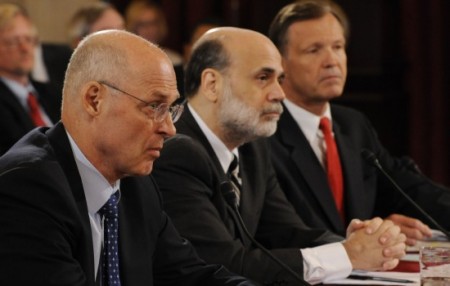
NEW YORK: In the narrative that has governed American commercial life for the last quarter-century, saving companies from their own mistakes was not supposed to be part of the government’s job description. Economic policymakers in the United States took swaggering pride in the cutthroat but lucrative form of capitalism that was supposedly indigenous to their frontier nation.
As faith in bank bailouts dims, losses set to deepen

NEW YORK (Reuters) – The nightmare scenario for U.S. economic authorities is here: confidence in their ability to rescue the country from a housing-led financial panic is now at its lowest level since the crisis began.
This means losses for investors, already totaling nearly half a trillion dollars, could mount even further over the next few months, with implications for business investment and the overall health of the economy.
“You see a massive potential for financial meltdown on a global scale,” said T.J. Marta, fixed-income strategist at RBC Capital Markets.
Federal Reserve Chairman Ben Bernanke and Treasury Secretary Henry Paulson, testified before Congress this week on the country’s precarious financial state. They were met with unusually fierce questions from lawmakers on the feasibility of a plan to provide extra funding for mortgage finance giants Fannie Mae (FNM.N: Quote, Profile, Research, Stock Buzz) and Freddie Mac (FRE.N: Quote, Profile, Research, Stock Buzz).
Read moreAs faith in bank bailouts dims, losses set to deepen
FREDDIE & FANNIE UNCONSTITUTIONAL BAIL OUT USING WHAT?
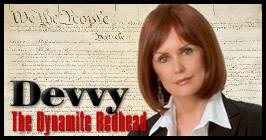
“As I write this column, Congress has run this country into a $9,498,511,404,143.63 debt. That’s just under $9.5 TRILLION “dollars.””
I really hope that you will find time to read this article. 🙂
_______________________________________________________________________________________
Arthur Henning of the Chicago Tribune said back in 1935, “The New Deal will bring the Communist Party within striking distance of overthrow of the American form of government…” Mark Sullivan of the Buffalo Evening News also expressed alarm in 1935: “The New Deal is to America what the early phase of Nazism was to Germany…”
The nation is awash in fear because they are coming to realize that while they’ve been buying all the hype from the cabal of gangsters in Washington for decades, reality is now setting in as poverty is slamming millions who used to belong to the middle class. From dangerous lending practices to the derivatives time bomb waiting to go off and inflation getting ready to launch into hyper inflation, the situation is more grim by the week. A financial catastrophe so many have been warning about for decades, it’s all coming home to roost. The “perfect storm” as it’s being called. The beast is now devouring itself and we the people are caught in their cross fire.
Unfortunately, most Americans haven’t been listening. They’re either addicted to sports, shopping, porn, drugs or yaking on their cell phones while the world has been heading for financial Armageddon.
Read moreFREDDIE & FANNIE UNCONSTITUTIONAL BAIL OUT USING WHAT?
US: $455,000 debt per household
As the Bush administration proposes backstopping mortgage giants Fannie Mae and Freddie Mac with a $300 billion line of credit and Congress contemplates another economic stimulus, the question is who will bail out the government?
“People seem to think the government has money,” said former U.S. Comptroller General David Walker. “The government doesn’t have any money.”
A rare consensus has developed across the political spectrum that the government’s own fiscal affairs are precarious, with an astonishing $53 trillion in long-term liabilities, according to the Government Accountability Office.
To put that number in human terms, the debt has reached $455,000 per U.S. household. As that debt grows, the United States increasingly relies on foreigners, including China and Middle East oil producers, for financing.
US faces global funding crisis, warns Merrill Lynch
Merrill Lynch has warned that the United States could face a foreign “financing crisis” within months as the full consequences of the Fannie Mae and Freddie Mac mortgage debacle spread through the world.

Draining away: The US may struggle to plug its capital gap
The country depends on Asian, Russian and Middle Eastern investors to fund much of its $700bn (£350bn) current account deficit, leaving it far more vulnerable to a collapse of confidence than Japan in the early 1990s after the Nikkei bubble burst. Britain and other Anglo-Saxon deficit states could face a similar retreat by foreign investors.
Read moreUS faces global funding crisis, warns Merrill Lynch
Jim Rogers: Fannie Plan a `Disaster’; Goldman Says Sell
The U.S. economy is in a recession, possibly the worst since World War II, Rogers said.
“They’re ruining what has been one of the greatest economies in the world,” Rogers said. Bernanke and Paulson “are bailing out their friends on Wall Street but there are 300 million Americans that are going to have to pay for this.”

July 14 (Bloomberg) — The U.S. Treasury Department’s plan to shore up Fannie Mae and Freddie Mac is an “unmitigated disaster” and the largest U.S. mortgage lenders are “basically insolvent,” according to investor Jim Rogers.
Taxpayers will be saddled with debt if Congress approves U.S. Treasury Secretary Henry Paulson‘s request for the authority to buy unlimited stakes in and lend to Fannie Mae and Freddie Mac, Rogers said in a Bloomberg Television interview. Rogers is betting that Fannie Mae shares will keep tumbling.
Goldman Sachs Group Inc. analyst Daniel Zimmerman said the mortgage finance companies’ shares may fall another 35 percent and lowered his share-price estimate for Fannie Mae to $7 from $18 and for Freddie Mac to $5 from $17. Freddie Mac fell 64 cents, or 8.3 percent, to $7.11 in New York Stock Exchange trading, while Fannie Mae fell 52 cents, or 5.1 percent, to $9.73.
“I don’t know where these guys get the audacity to take our money, taxpayer money, and buy stock in Fannie Mae,” Rogers, 65, said in an interview from Singapore. “So we’re going to bail out everybody else in the world. And it ruins the Federal Reserve’s balance sheet and it makes the dollar more vulnerable and it increases inflation.”
The chairman of Rogers Holdings, who in April 2006 correctly predicted oil would reach $100 a barrel and gold $1,000 an ounce, also said the commodities bull market has a “long way to go” and advised buying agricultural commodities.
`Solvency Crisis’
Read moreJim Rogers: Fannie Plan a `Disaster’; Goldman Says Sell
Run on banks spells big trouble for US Treasury
IN A modern financial system nothing is more frightening than a run on the bank. The US has now suffered a series of them, and they are escalating in size and scope, posing a serious threat to an already reeling economy.
Rumours swamped financial markets on Friday that the US Government would be forced to step in to aid the mortgage finance giants Fannie Mae and Freddie Mac, which together own or guarantee $US5 trillion ($5.16 trillion) in US home loans.
In Wall Street’s version of a run on the bank, investors drove Fannie Mae and Freddie Mac shares to 17-year lows, signalling a gnawing lack of faith in the companies’ ability to survive rising mortgage defaults without the Government’s help.
Later on Friday regulators took over IndyMac Bank of Pasadena, saying the $US32 billion lender had collapsed under the weight of bad home loans and withdrawals by spooked depositors. It was the second-largest bank to fail in US history.
Friday’s events were felt around the world, knocking the battered US dollar lower and driving up interest rates.
“This is a flare-up in the financial forest fire that is far beyond anything we’ve seen before,” said Christopher Low, chief economist at the investment firm FTN Financial in New York.
It is triggering worries that would have been unthinkable even a year ago, including that the US Treasury’s debt might lose its AAA credit grade because of heavy blows to the nation’s fiscal health from the housing mess.
Four months ago many on Wall Street believed they had seen the worst of the credit crisis rooted in the housing market’s woes. The collapse in March of the brokerage Bear Stearns, a central player in the business of packaging dicey mortgages for sale to investors, was the kind of prominent calamity that has historically marked the end of financial crises.
Dollar Diving
Dollar to fall to metals in upcoming rallies, rate hikes soon wont be able to fix economic problems, real inflation understated for years, USDX contracts plummet, why arent people fleeing from the stock market… Exchange Traded Funds are a disaster, losses from global write downs, Fed still invited to intervene in spite of failures
The dollar has once again collapsed. Get ready for the next dollar debacle and the coming rally in gold and silver which have just broken out. The elitists have lost all credibility. The would-be lords of the universe have told so many pathological lies that no one “in the know” believes anything emanating from the forked tongues of Buck-Busting, Bear-Bashing, Big-Ben Bernanke and Hanky Panky Paulson. If our Fed Head and Treasury Secretary had been characters in the Walt Disney movie entitled “Pinocchio,” their noses would have quickly grown to lengths that could have been wrapped around the earth’s equator several times. God would have had to reverse the earth’s rotation to extricate them.
Wall Street tells us the odds favor two quarter percent rate hikes to the Fed funds rate by the end of the year. We ask whether that would be before or after the economy collapses? If before, the Fed’s rate hikes will destroy what is left of our economy, and the dollar will collapse, thereby erasing any benefits from the rate hikes. If after, you will see rate cuts instead of rate hikes as the Fed attempts to save the fraudsters on Wall Street who are not even remotely close to recovering from the credit-crunch despite what the elitists might tell you to the contrary. We ask who the morons are that make up these odds, and what planet they come from. They give aliens a bad name. These index predictions are just another form of jaw-boning and disinformation.
As soon as the economy starts its final descent into Davy Jones’ Locker, which is likely to occur in the very near future, the Fed and the US Treasury will unceremoniously toss the so-called “strong dollar” policy into the nearest financial dumpster in order to save the economy and the fraudsters. Accompanying the “strong dollar” policy on its way to the dumpster will be the next round of derivative toxic waste that is on its way courtesy of the upcoming surge in fallout from tanking real estate markets in a process that will see the Fed blow what remains of its general collateral in exchange for such waste. Once the Fed’s general collateral is exhausted, we will be ushered into a new hyperinflationary era characterized by direct monetization of US treasuries to fund our deficits and to absorb more toxic waste as it continues to pour down on elitist financial institutions like Niagara Falls.
A few measly quarter percent cuts will do absolutely nothing to slow the acceleration of inflation, especially if the Fed keeps the M3 at current levels. Only a double-digit Fed funds rate and greatly reduced M3 could have any eventual and meaningful impact on the inflation that is built into the system for at minimum the next year and one half at levels in the area of 15% to 18%, and even then the impact will not be felt until the current baked-in inflation has run its course. Direct monetization of treasuries to replenish Fed collateral and to absorb our growing deficits will put inflation beyond the point of no return, as will the breaking of OPEC dollar pegs.
As you can see, there is no way that any of the proposed diminutive rate hikes will have a positive impact on the economy, on the dollar or on the balance sheets of the fraudsters. Therefore, there will not be any rate hikes. Any increase in the Fed funds rate would be accompanied by an economic catastrophe of epic proportions that would occur as a direct result of the raising of that rate. Any rate hike would take a year to a year and a half to have an impact on inflation. By the time the anticipated Fed rate hikes could have any kind of impact whatsoever, the economy will already be in a state of rampant hyperinflation, and would be well on its way to depression, far too late to save the dollar or the economy. Ergo, the new elitist motto will soon become: “Damn the inflation, full greed ahead!”
Bilderberg Seeks Bank Centralization Agenda
“Jim Tucker from the American Free Press speaking on the Alex Jones show today stated that one of his Bilderberg sources revealed to him that the global elite are planning to push forward their cashless society grid agenda with the use of implantable microchips. The implantable microchips would be sold as a way for people to easily move through the militarized control grid that they’ve setup via the bogus terror war.”
_________________________________________________________________________________________
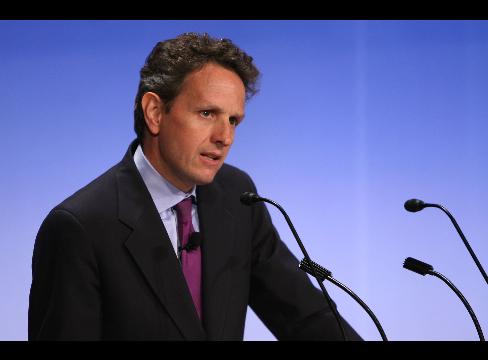
Fresh off of the 2008 Bilderberg Meeting, it looks as if New York Federal Reserve president Timothy Geithner is set to push a new agenda in the world of central banking that was likely decided upon at Bilderberg. Geithner yesterday, wrote an article in the Financial Times calling for a global regulatory banking framework.
In addition, Geithner called for the Federal Reserve to have an instrumental role in this new framework. Geithner cites all of the problems that were actually created by the central bankers in the first place as the rationale for having greater centralized power. It is interesting Geithner decides to write this piece right after the Bilderberg Meeting where some of the most powerful figures in the world of central banking attended.
With the who’s who of central banking attending the Bilderberg Meeting, it is highly unlikely that what Geithner is proposing in his Financial Times article was not discussed at the Bilderberg Meeting. It is no secret that the true objective of the Bilderberg Meeting is to steer the world into accepting a global government.
By establishing a new global regulatory banking framework, this will inch the planet ever closer to a one world currency operating in a cashless society where microchips are used to facilitate transactions. Make no mistake about it, this system will not be good, because it will be controlled by a bunch of criminal psychopaths like the one’s who attended the 2008 Bilderberg Meeting.
In his Financial Times article, Geithner wrote the following:
Fed Attentive To Sagging Dollar?
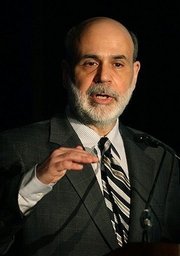
Federal Reserve chairman Ben Bernanke, in unusually sharp comments on foreign exchange, said Tuesday the central bank is “attentive” to the sagging dollar because of its potential impact on inflation.
Bernanke, speaking via satellite to a monetary conference in Barcelona, Spain, offered a mixed assessment of US economic conditions, while highlighting concerns about inflation and the dollar.
His comments on currency marked a first for Bernanke, who normally defers to the Treasury on such matters.
“The challenges that out economy has faced over the past year or so have generated some downward pressure on the foreign exchange value of the dollar, which have contributed to the unwelcome rise in import prices and consumer price inflation,” he said, according to the text of the remarks released in Washington.
“We are attentive to the implications of the changes in the value of the dollar for inflation and inflation expectations and will continue to formulate policy to guard against risks to both parts of our dual mandate, including the risk of an erosion in longer-term inflation expectations.”
The Fed’s dual mandate is to maintain price stability and promote maximum employment in the US economy.
Bernanke maintained that “the Federal Reserve’s commitment to both price stability and maximum sustainable employment … will be key factors ensuring that the dollar remains a strong and stable currency.”
The greenback strengthened after the comments, with the euro falling to 1.5449 dollars from 1.5540 in New York late on Monday.
Bernanke noted that “in collaboration with our colleagues at the Treasury, we continue to carefully monitor developments in foreign exchange markets.”
“This is a major shift for the Federal Reserve towards the US dollar as chairman Bernanke specifically mentions the importance of the currency for the Federal Reserve,” said Andrew Busch at BMO Capital Markets.
“This should mean the (Fed) is concerned about the lower value of the currency on inflation and thus the likely reluctance of the interest rate setting body to lower interest rates further. And perhaps signals that rates are poised to be raised in the future due to inflation.”
Pentagon Cannot Account for For $15 Billion
The inspector general for the Defense Department said yesterday that the Pentagon cannot account for almost $15 billion worth of goods and services ranging from trucks, bottled water and mattresses to rocket-propelled grenades and machine guns that were bought from contractors in the Iraq reconstruction effort.
The Pentagon did not have the proper documentation, including receipts, vouchers, signatures, invoices or other paperwork, for $7.8 billion that American and Iraqi contractors were paid for phones, folders, paint, blankets, Nissan trucks, laundry services and other items, according to a 69-page audit released to the House Committee on Oversight and Government Reform.
An earlier audit by the inspector general found deficiencies in accounting for $5.2 billion of U.S. payments to buy weapons, trucks, generators and other equipment for Iraq’s security forces. In addition, the Defense Department spent $1.8 billion of seized Iraqi assets with “absolutely no accountability,” according to Rep. Henry A. Waxman (D-Calif.), who chairs the oversight committee. The Pentagon also kept poor records on $135 million that it paid to its partners in the multinational military force in Iraq, auditors said.
Silver Eagles Shortage
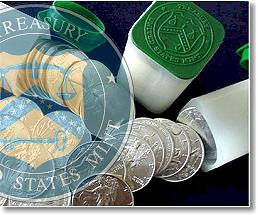
The government rationed food during World War II and gasoline in the 1970s. Now, it’s imposing quotas on another precious commodity: 2008 dollar coins known as silver eagles.
The coins, each containing about an ounce of silver, have become so popular among investors seeking alternatives to stocks and real estate that the U.S. Mint can’t make them fast enough. In March, the mint stopped taking orders for the bullion coins. Late last month, it began limiting how many coins its 13 authorized buyers world-wide are allowed to purchase.
“This came out of nowhere,” says Mark Oliari, owner of Coins ‘N Things Inc. in Bridgewater, Mass., one of the biggest buyers of silver eagles. With customers demanding twice as many as they did last year, Mr. Oliari would like to buy 500,000 a week. But the mint will sell him only around 100,000.
Oppositon to Iran Attack
Editor’s Note: Although this document, authored by House Judiciary Chairman John Conyers, Jr., contains a direct appeal for political action we feel it is nonetheless striking. It is news unto itself. As such we offer it as news. ma/TO
From: The office of House Judiciary Chairman John Conyers, Jr.
May 8, 2008
Join Me in Calling on President Bush to Respect Congress’ Exclusive Power to Declare War
Dear Democratic Colleague:
As we mark five years of war in Iraq, I have become increasingly concerned that the President may possibly take unilateral, preemptive military action against Iran. During the last seven years, the Bush Administration has exercised unprecedented assertions of Executive Branch power and shown an unparalleled aversion to the checks and balances put in place by the Constitution’s framers. The letter that follows asks President Bush to seek congressional authorization before launching any possible military strike against Iran and affirms Senator Biden’s statement last year that impeachment proceedings should be considered if the President fails to do so.
I hope that you will join me in calling on the President to respect Congress’ exclusive power to declare war. To sign the letter below, please contact the Judiciary Committee staff at 225-3951.
Sincerely,
John Conyers, Jr.
Chairman
May 8, 2008
The Honorable George W. Bush
President of the United States
1600 Pennsylvania Avenue, N.W.
Washington, D.C. 20500
Dear Mr. President:
We are writing to register our strong opposition to possible unilateral, preemptive military action against other nations by the Executive Branch without Congressional authorization. As you know, Article I, Section 8 of the U.S. Constitution grants Congress the power “to declare war,” to lay and collect taxes to “provide for the common defense” and general welfare of the United States, to “raise and support armies,” to “provide and maintain a navy,” to “make rules for the regulation for the land and naval forces,” to “provide for calling forth the militia to execute the laws of the Union, suppress insurrections and repel invasions,” to “provide for organizing, arming, and disciplining, the militia,” and to “make all laws necessary and proper for carrying into execution … all … powers vested by this Constitution in the Government of the United States.” Congress is also given exclusive power over the purse. The Constitution says, “No money shall be drawn from the Treasury but in consequence of appropriations made by law.”
By contrast, the sole war powers granted to the Executive Branch through the President can be found in Article II, Section 2, which states, “The President shall be the Commander-in-Chief of the Army and Navy of the United States, and of the Militia of the several States, when called into actual Service of the United States.” Nothing in the history of the “Commander-in-Chief” clause suggests that the authors of the provision intended it to grant the Executive Branch the authority to engage U.S. forces in military action whenever and wherever it sees fit without any prior authorization from Congress. In our view, the founders of our country intended this power to allow the President to repel sudden attacks and immediate threats, not to unilaterally launch, without congressional approval, preemptive military actions against foreign countries. As former Republican Representative Mickey Edwards recently wrote, “[t]he decision to go to war … is the single most difficult choice any public official can be called upon to make. That is precisely why the nation’s Founders, aware of the deadly wars of Europe, deliberately withheld from the executive branch the power to engage in war unless such action was expressly approved by the people themselves, through their representatives in
Congress.” [1]
Related quote: “Stop throwing the Constitution in my face. It’s just a goddamned piece of paper!” – G.W.Bush
Fed `Rogue Operation’ Spurs Further Bailout Calls

Ben Bernanke, chairman of the U.S. Federal Reserve, arrives at the Federal Reserve building for a Federal Reserve Open Market Committee meeting in Washington, April 29, 2008. Photographer: Brendan Smialowski/Bloomberg News
May 2 (Bloomberg) — A month after the Federal Reserve rescued Bear Stearns Cos. from bankruptcy, Chairman Ben S. Bernanke got an S.O.S. from Congress.
There is “a potential crisis in the student-loan market” requiring “similar bold action,” Chairman Christopher Dodd of Connecticut and six other Democrats wrote Bernanke. They want the Fed to swap Treasury notes for bonds backed by student loans. In a separate letter, Pennsylvania Democratic Representative Paul Kanjorski and 31 House members said they want Bernanke to channel money directly to education-finance firms.
Student loans are just the start. Former Fed officials and other Fed-watchers say that Bernanke’s actions in saving Bear Stearns will expose the central bank to continuing pressure to use its $889 billion balance sheet to prop up companies or entire industries deemed important by politicians. The Fed satisfied Dodd’s request today, expanding the swaps to include securities backed by student debt.
“It is appalling where we are right now,” former St. Louis Fed President William Poole, who retired in March, said in an interview. The Fed has introduced “a backstop for the entire financial system.”
Critics argue that the result will be to foster greater risk-taking among investors emboldened by the belief that the government will bail them out of bad decisions.
The Fed’s loans to Bear Stearns were “a rogue operation,” said Anna Schwartz, who co-wrote “A Monetary History of the United States” with the late Nobel laureate Milton Friedman.
`No Business’
“To me, it is an open and shut case,” she said in an interview from her office in New York. “The Fed had no business intervening there.”
Federal Reserve may Want Inflation
We are now importing inflation. This does not only apply to the cost of commodities, such as oil, but also to consumer goods imported from Asia. This is a newer trend as, in our analysis, Asia had been exporting deflation until the summer of 2006; since then, we have seen increased pricing power by Asian exporters.
Inflation is not just a U.S. phenomenon; as Asian economies are far more dependent on agricultural and industrial commodities, rising inflation may become a serious concern in the region. The stronger and more prudent Asian central banks may realize that allowing their currencies to float higher versus the U.S. dollar may be the most effective way to combat inflationary pressures.
U.S. risks stagflation, says BIS chief
BASEL, Switzerland, April 29 (Reuters) – Stagflation is an increasingly plausible prospect in the United States and weak economic growth could last well into 2009, if not longer, the head of the Bank for International Settlements says.
That does not herald a rerun of the economic stagnation and rampant inflation that ran riot during the 1970s when oil prices last soared to unprecedented levels, Malcolm Knight, BIS general manager, said in an interview.
But it does cast some doubt on the White House’s thesis that the economy will rebound in the second half of 2008 in response to the tens of billions of dollars of tax rebates the government will be delivering to U.S. households in the coming weeks.
“I see a certain amount of scope for stagflation in a number of economies and that usually tends to result in subpar economic growth performance for an extended period of time, which could go well into 2009 or even longer,” said Knight, a Canadian who worked for more than 20 years at the International Monetary Fund.
“I think the U.S. economy is likely to experience weakness this year and in much of 2009,” said Knight, speaking to Reuters at BIS headquarters in Basel, Switzerland.
“Stagflation is a definite risk.”
A Trillion Dollar Rescue for Wall Street Gamblers
Nothing for Families and Retirees
If the move to a Unitary Executive of unfettered presidential power frightens you, America’s radical right turn to Unitary Finance should compound your fears–and your debts as well. The financial events of the last two weeks of March 2008 demonstrate that the “economic royalists” and “money changers” whom Franklin Delano Roosevelt (FDR) drove from the temple of finance have returned to mismanage our economy into dire straights of unprecedented risk–debt creation, euphemized as “leveraging” and “wealth creation.”
The few checks and balances that remain in the way of the financial sector’s increasingly centralized planning, especially at the state level, are being swept aside under the guise of “saving the system.” Few Wall Street beneficiaries who use this phrase explain just what the system is. For starters, its political managers are industry lobbies appointed to high managerial and planning positions in the public agencies that are supposed to regulate these industries. Their idea of financial planning is to put a trillion dollars in government agency funds and credit guarantees at risk. This agency funding was supposed to be used to help average American families obtain housing and health care, and to protect their savings and provide for their retirement. Instead, it is being mobilized to support the economy’s bankers and financial managers. Indeed, the past few weeks have seen seemingly trillions of dollars committed for war making and bank support.
The banking system’s free creation of credit, doubling each five years or so for the economy at large, threatens to culminate in debt peonage for many American families and also for industry and for state and local governments. The economic surplus is being quickly absorbed by a combination of debt service and government bailouts for creditors whose Ponzi schemes are collapsing right and left, from residential to commercial real estate and corporate takeover loans to foreign bubble-economy credit.
This is the context in which to view the past few weeks’ financial turmoil surrounding Bear Stearns, JPMorgan/Chase and the rapidly changing debt landscape. “The system” that the Treasury, Federal Reserve and the New Deal agencies captured by the Bush Administration is trying to save is an economy-wide Ponzi scheme. By that I mean that the business plan is for creditors to lend debtors enough money for them to pay the interest costs so as to keep current on their loans.
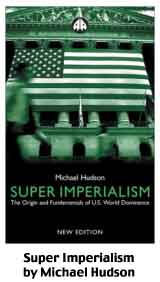 Super Imperialism – New Edition: The Origin and Fundamentals of U.S. World Dominance
Super Imperialism – New Edition: The Origin and Fundamentals of U.S. World Dominance
Fed: Severe Downturn Possible
WASHINGTON (Reuters) – Members of the Federal Reserve’s policy-setting committee worried at their most recent meeting that housing and financial market stress could trigger a nasty slide in the economy, even as inflation pushed higher, minutes of the meeting released on Tuesday show.

“Some believed that a prolonged and severe economic downturn could not be ruled out given the further restriction of credit availability and ongoing weakness in the housing market,” minutes of the March 18 meeting said.
Fed economists presented a somber picture of short-term prospects — central bank staff now fully expect negative growth over the first six months of the year — but held out the possibility of a modest rebound later.
“The staff projection showed a contraction of real GDP in the first half of 2008 followed by a slow rise in the second half,” the report said, referring to gross domestic product, a broad measure of a country’s output of goods and services.
At the same time, Fed officials found recent inflation reports “disappointing,” noting also with concern that some indicators of inflation expectations were edging higher.
DHS reckons US cops’ access to sat-surveillance is go
“I think the way is now clear to stand NAO up and go warm,” said Chertoff, briefing journalists about the proposed National Applications Office.
NAO would allow US police, immigration, drug-enforcement and other officials to have access to data from various US satellites passing above America. It is understood that the information would be supplied mostly by spacecraft which at the moment are used for meteorological and geological surveying, or other scientific tasks. Satellites of this type can often deliver high-resolution images which would also be useful to law enforcement.
Read moreDHS reckons US cops’ access to sat-surveillance is go
On the brink of disaster
The three newbies – the term auction lending facility, the primary-dealer credit facility, and the term securities lending facility – total more than half-a-trillion dollars, with more if needed. Much of this money is available not only to commercial banks but also to investment banks, which normally aren’t allowed to borrow from the Fed.
How can the Fed afford this largesse? Easy. Unlike a normal lender, the Fed can’t run out of money – at least, I don’t think it can. It can manage monetary policy while in effect creating banking reserves out of thin air and lending them out at interest.
That’s how the Fed reported a $34 billion profit in 2006, the last available year, of which $29 billion was sent to the Treasury. The Fed can even add to its $800 billion stash of Treasury securities by borrowing more of them from other big players.
Then there’s the Treasury. In March the Treasury – which failed this past winter to get private firms to establish a $100 billion “superfund” (please, no giggles from people who equate the term with Love Canal) to keep things called “structured investment vehicles” from having to sell their holdings in a bad market – unleashed Fannie Mae (FNM) and Freddie Mac (FRE, Fortune 500) and the Federal Home Loan Banks to buy hundreds of billions of dollars of mortgage-backed securities.
Treasury’s Plan Would Give Fed Wide New Power
“The Fed would have the authority to go wherever in the system it thinks it needs to go for a deeper look to preserve stability,” Mr. Paulson said in the advance text of Monday’s speech. “To do this effectively, it will collect information from commercial banks, investment banks, insurance companies, hedge funds, commodity pool operators.”
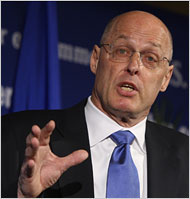
WASHINGTON – The Treasury Department will propose on Monday that Congress give the Federal Reserve broad new authority to oversee financial market stability, in effect allowing it to send SWAT teams into any corner of the industry or any institution that might pose a risk to the overall system.
The proposal is part of a sweeping blueprint to overhaul the nation’s hodgepodge of financial regulatory agencies, which many experts say failed to recognize rampant excesses in mortgage lending until after they set off what is now the worst financial calamity in decades.
Ten Days That Changed Capitalism
Officials Improvised
To Rescue Markets;
Will It Be Enough?
The past 10 days will be remembered as the time the U.S. government discarded a half-century of rules to save American financial capitalism from collapse.
Paulson: Social Security Unsustainable

US Treasury Secretary Henry Paulson said Tuesday that America’s Social Security program for the retired is “financially unsustainable” and needs an urgent overhaul.